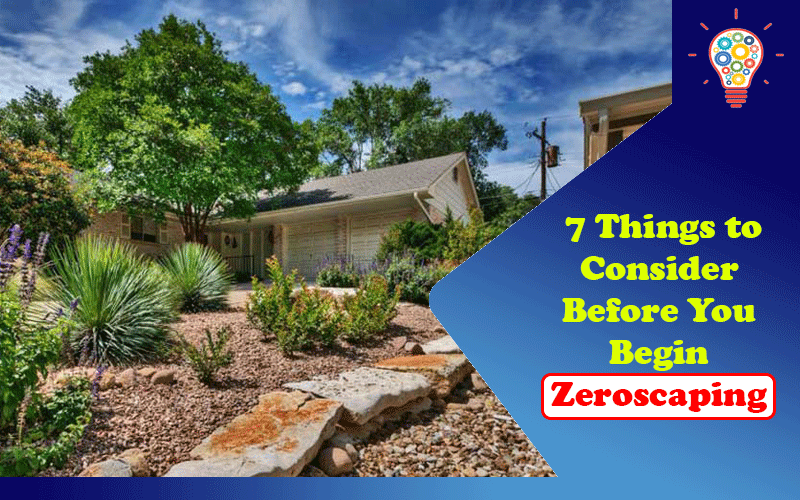You’ve probably heard the word “zeroscaping” thrown around in landscaping community forums, especially if you went looking for ways to maintain a garden while conserving water.
Sometimes spelled “xeriscaping,” this is a practice of low-water landscaping. Instead of growing high-maintenance grass and needy flowers and their properties, zeroscapers embrace cacti, succulents, and other low-maintenance plants.
Sound fun? Of course, it does!
But there are a few things you should know before you start scattering rocks around your property and planting cacti along your walkway.
Here are seven things you need to know before you begin zeroscaping:
Table of Contents
1. Create a Water Conservation Plan
Over 97 percent of our planet’s water is salt water, with two percent of the available fresh water stored in ice caps. There’s an urgent need to use fresh water responsibly, as the entire ecosystem depends on fresh water.
The idea behind zeroscaping is water conservation, but you don’t have to live in a dry region to practice it. You can introduce this form of landscaping anywhere!
Keeping water preservation in mind, consider coming up with a conservation plan beforehand.
Think of how you’re going to implement your landscape designs while maintaining the main objective of minimizing water usage.
This kind of planning should factor in expected costs, aesthetic appeal, and maintenance needs.
2. Research Your Plants

The plants you choose for your zeroscape play a key role in your water conservation efforts.
You have to choose plants carefully if you want to realize the goal of water-wise gardening.
Try to make sure that the majority of plants you use are native to the environment. This increases the chances that your garden will succeed and can save you a big headache later on.
You see, the problem with exotic plants is that they might not survive in your region. Whether it’s the climate, pests, or water supply, they may not be well-suited to live with you.
So, before you start planting, do your research to find out if the plants you want can live in your corner of the world.
3. Use an Efficient Irrigation System
Zeroscaping involves drought-tolerant plants for the most part.
Still, occasional irrigation is necessary, especially during the first stages when your garden is growing and hasn’t yet established strong roots.
Now, if you don’t have a proper irrigation system in place, you’ll end up doing the opposite of water-wise gardening.
The recommended irrigation system for zeroscapes is drip irrigation. It’s the best form of irrigation when it comes to saving water, as it’s designed to slowly and directly drop water on individual plant roots.
The idea is to limit evaporation and water waste by delivering water directly to the root area.
4. Practice Mulching
Mulching is an excellent system that you should definitely consider when it comes to zeroscaping. It’s effortless and costs nothing, but the benefits are immense.
In a harsh environment where water is scarce, you want to give your garden the best chance of survival, and this is where mulching proves vital.
The practice acts as insulation, protecting the soil against the sun and other drying agents like wind.
This helps plants retain moisture for much longer and keeps your garden safe from weeds.
5. Group Perennial Plants

You may want to use perennial plants instead of annual or biannual ones because they are way more adaptive to harsh conditions.
Depending on the species, perennials can live for decades. Once established, perennials’ rooting systems go deep, far beyond the reach of seasonal plants. This allows them to access water regardless of the surrounding conditions.
Now, why do you need to group perennial plants?
You still need to provide adequate water until your plants have well-established roots.
And when you group plants with similar water needs together, you’ll use less water.
6. Introduce Shade Trees
Dotting your garden with shady trees is a great way to protect smaller plants against excess heat and wind, which is common in dry areas.
Shady trees also minimize moisture evaporation by providing shelter to the smaller plants, in turn reducing their water needs.
Besides, you don’t need a large tree in your garden if it’s not part of your vision. You can use drought-resistant shrubs and bushes to create a good cover. Any tree services provider like thelocaltreeexpert.com can help you with this.
7. Preserve and Use Rainwater
Compared to water sources like surface and groundwater, rainwater is by far the most beneficial for plants. It doesn’t contain pollutants like salts and other chemicals.
When it rains, you need to prevent it from becoming stormwater, as this running water can easily get contaminated, and you don’t want it finding its way into your garden.
Find a way to Riverside arborists for tree planting tips to capture and preserve rainwater as it also cuts down on the need for fresh household water.
Conclusion
Landscape irrigation accounts for one-third of all freshwater use, putting a serious strain on the supply. And we need freshwater for human and animal consumption, as well as agriculture, more than ever.
Zeroscaping is the answer when it comes to keeping beautiful landscapes while using water responsibly. And if you’re thinking about getting houseplants that require a lot of water, this is an eco-friendly alternative!
Visit the rest of the site for more informational articles.
 Bio:
Bio:
Caitlin Sinclair is the property manager at Cielo at Little Italy. She has a passion for her community and looks forward to making Cielo at Little Italy the place to call home.


12 thoughts on “7 Things to Consider Before You Begin Zeroscaping”